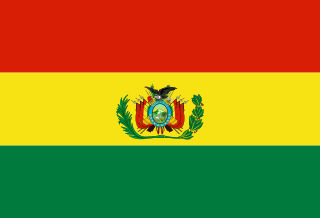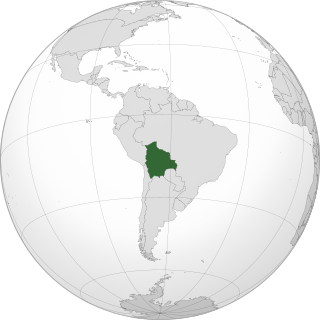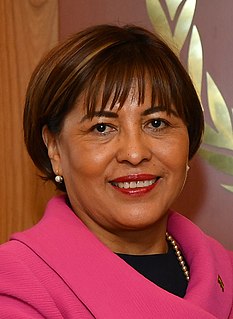Related Research Articles

The Armed Forces of Bolivia are official organizations responsible for the defence, both of external and internal, of Bolivia and they are constituted by Bolivian Army, the Bolivian Air Force and the Bolivian Navy. All these institutions depend on the Ministry of Defence of this country.

The Movement for Socialism–Political Instrument for the Sovereignty of the Peoples, alternately referred to as the Movement Toward Socialism or the Movement to Socialism, is a Bolivian left-wing populist and indigenist political party led by Evo Morales, founded in 1998. Its followers are known as Masistas.
The Confederation of Indigenous Peoples of Bolivia,, is a national representative organization of the Bolivian indigenous movement. It was founded in October 1982 in Santa Cruz de la Sierra as the Confederation of Indigenous Peoples of the Bolivian East, with the participation of representatives of four indigenous peoples of the Bolivian East: Guarani-Izoceños, Chiquitanos, Ayoreos and Guarayos.

The Bolivian Army is the land forces component of the Armed Forces of Bolivia. Figures on the size and composition of the Bolivian army vary considerably, with rare official data available. It is estimated, however, that the army has between 26,000 to 60,000 men.
The South American Games, formerly the Southern Cross Games is a regional multi-sport event held between nations from South America, organized by the South American Sports Organization.

Tomes's sword-nosed bat, also known as the common sword-nosed bat is a bat species from South and Central America. It is also found in the Bahamas, as is known only from one specimen collected on the island of New Providence.

Fernandez's sword-nosed bat is a species of bat in the family Phyllostomidae. It is the smallest species of the Lonchorhina genus. It is endemic to Venezuela. In 2013, Bat Conservation International listed this species as one of the 35 species of its worldwide priority list of conservation. It is threatened by habitat loss. It derives its scientific name from a Venezuelan zoologist, Dr. Alberto Fernandez Badillo, whose research focused on vampire bats, in particular.

Isiboro Sécure National Park and Indigenous Territory is a protected area and Native Community Land in Bolivia situated between the north of the Cochabamba Department and the south of the Beni Department. It protects part of the Bolivian Yungas ecoregion. The indigenous people living within the park belong to the Tsimané, Yuracaré, and Mojeño-Trinitario peoples. The southern portion of the park has been colonized by agricultural settlers, primarily coca farmers, since the 1970s. The Bolivian government estimates that 10% of the park has been deforested by their presence.
Mariana Alandia Navajas (Tarija) is a Bolivian classical pianist who interpreted most of the 20th century Bolivian classical composers.

The history of the Jews in Bolivia stretches from the colonial period of Bolivia in the 16th century to the end of the 19th century. In the 19th century, Jewish merchants came to Bolivia, most of them taking local women as wives and founding families that merged into the mainstream Catholic society. This was often the case in the eastern regions of Santa Cruz, Tarija, Beni and Pando, where these merchants came either from Brazil or Argentina.
Blanca Wiethüchter López was a Bolivian writer, historian, and publisher. Wiethüchter's parents were German immigrants. She became one of the most enigmatic and recognized authors of Bolivian literature in the 20th and 21st centuries. She published essays, short stories, and poems. Hers was one of the iconic female voices of Bolivian poetry of the late 20th century. Her writing spanned three decades, from the mid-1970s until her death in 2004. She graduated in Letters from the Higher University of San Andrés and in Learning sciences from the Sorbonne; she earned a Master's degree in Latin American Literature at the University of Paris. Wiethüchter was editor of the cultural supplement in "La Hormiga Eléctrica" in of the literary magazines ""Hipótesis" and "Piedra Imán". She served as editorial director of ""Hombrecito sentado" and "Mujercita Sentada""; and was the co-founder of the cultural space Puraduralubia (1993). She taught at the Catholic University of Bolivia and the Higher University of San Andrés. Wiethüchter died in 2004 in Cochabamba.

Julieta Montaño is a Bolivian attorney, human rights defender, woman's rights activist, feminist writer and a 2015 winner of the US State Department's International Women of Courage Award.

Elsa Nadezhda Bravo Cladera is a Bolivian linguist, researcher and writer. She is a Doctor of Philosophy in Romance Languages from the University of Uppsala. She is "Miembro Correspondiente" of the Academia Boliviana de la Lengua.

The Thomas van der Hammen Natural Reserve or Thomas van der Hammen Forest Reserve is an area of the Bogotá savanna that is under environmental protection. The natural reserve was declared as such in year 2000 by the Ministry of Environment and Sustainable development. It takes its name from the Dutch-Colombian geologist Thomas van der Hammen who devoted his life to the research of the region. The surface area of the protected reserve is approximately 1,395 hectares and it is located in the north of Bogotá.

Lilly Gabriela Montaño Viaña is a Bolivian physician, politician, and former senator. She was the elected President of the Plurinational Legislative Assembly, a position she accepted and would hold until 2020 while still the presidential representative of Santa Cruz de la Sierra for the Movement for Socialism (MAS) party. In 2012, Montaño was made the acting President of Bolivia for a short time. Montaño is a feminist and vocal defender of the rights of the LGBT community. She has been a regular guest and speaker at forums and conferences in different parts of the world. She married Argentine citizen Fabián Restivo, with whom she has had two daughters.

Silvia Velarde Pereyra, better known by her stage name, Sibah, is a Bolivian blues and rock and roll singer-songwriter.
Dení Ramírez Macías is a Mexican marine biologist ocean scientist, and conservationist, and director of Whale Shark México since 2003. She leads the "Giants of Peru" project of the Save Our Seas Foundation.

Nardi Elizabeth Suxo Iturry is a Bolivian lawyer and sociologist. She served as the ambassador of Bolivia to Austria, Croatia, Hungary, and Slovakia from June to November 2019.

Mónica Eva Copa Murga is a Bolivian social worker and politician who served as President of the Senate between 2019 and 2020. She additionally served as a senator for La Paz Department between 2015 and 2020. Copa is a member of the political party Movement for Socialism. She became President of the Senate following the resignation of Adriana Salvatierra and other high-ranking Movement for Socialism officeholders, and the ascension of Jeanine Áñez as President of Bolivia amidst the 2019 Bolivian political crisis.

Narel Paniagua-Zambrana is a scientist specializing in ethnobotany. She investigates the use and protection of traditional knowledge of plants in indigenous communities, particularly in the Bolivian Andes. Her goal is giving them the knowledge to participate in decision-making on the conservation of their intangible cultural heritage.
References
- ↑ Pau, Alejandra (17 November 2013). "Bolivian Kathrin Barboza, defender of bats that impacts science". Bolivian Thoughts in an Emerging World. Retrieved 31 October 2015.
- 1 2 Industry (2014-01-13). "Kathrin Barboza | Bolivianos destacados". Kathrin Barboza | Bolivianos destacados. Retrieved 2020-01-31.
- 1 2 3 4 5 Oblitas Zamora, Mónica (27 October 2013). "Kathrin Barboza, una científica "top" en américa latina" (in Spanish). Cochabamba, Bolivia: Los Tiempos. Archived from the original on 31 October 2015. Retrieved 31 October 2015.
- ↑ "Plan de Acción para la Conservación de los Murciélagos Amenazados de Bolivia" (PDF) (in Spanish). Cochabamba, Bolivia: International Union for Conservation of Nature. 2010. Retrieved 31 October 2015.
- 1 2 3 4 5 6 7 8 9 "Holy biodiversity! Bat biologist Kathrin Barboza discusses protecting Bolivia's nocturnal flyers — Assembly | Malala Fund". Assembly. Retrieved 2020-01-31.
- 1 2 "Kathrin Barboza, la bióloga que redescubrió un murciélago que se creía extinto en Bolivia - Diario Pagina Siete". www.paginasiete.bo (in Spanish). Retrieved 2020-01-31.
- 1 2 Rodríguez, Margarita (16 October 2013). "10 mujeres que lideran la ciencia en América Latina" (in Spanish). BBC. Retrieved 1 November 2015.
- 1 2 "Una boliviana entre las 10 mujeres que lideran la ciencia en América Latina" (in Spanish). Santa Cruz, Bolivia: El Día. 16 October 2013. Retrieved 31 October 2015.
- 1 2 3 4 5 Pau, Alejandra (14 November 2013). "Kathrin Barboza, la defensora de murciélagos que impacta a la ciencia" (in Spanish). La Paz, Bolivia: Pagina Siete. Retrieved 1 November 2015.
- ↑ "De las plagas de insectos a la flor del tequila, nuestro aliado el murciélago" (in Spanish). Madrid, Spain: La Informacion. EFE. 22 August 2014. Retrieved 31 October 2015.
- ↑ "Bat Pollination". U.S. Forest Service. Retrieved 1 November 2015.
- 1 2 "Murciélagos sonidos urbanos" (in Spanish). Madrid, Spain: La Razon. EFE. 1 July 2012. Retrieved 31 October 2015.
- ↑ "Arrivals" (PDF). STRI News. 15 February 2008. Retrieved 31 October 2015.
- ↑ "Ectoparásitos de los murciélagos de Bolivia" (in Spanish). La Paz, Bolivia: Programa para la Conservación de los Murciélagos de Bolivia. 15 June 2011. Retrieved 1 November 2015.
- ↑ "Joven científica boliviana gana una de las becas Unesco-L'Oreal" (in Spanish). La Paz, Bolivia: La Patria. 30 March 2012. Retrieved 31 October 2015.